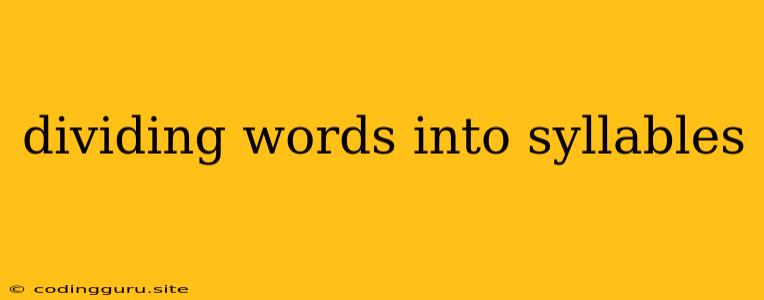Dividing Words into Syllables: A Guide to Understanding and Mastering the Skill
Have you ever struggled to pronounce a long word, feeling like it's one giant tongue twister? Or maybe you're trying to help your child learn how to read, and understanding syllables seems like a hurdle. Regardless of the reason, knowing how to divide words into syllables is a crucial skill in language development and reading fluency.
What are Syllables?
A syllable is a unit of pronunciation that consists of a single vowel sound, with or without surrounding consonants. Think of it as a beat in a word, like the "clap" in "clap-ping" or the "tap" in "tap-ping." Every word has at least one syllable, and longer words can have multiple syllables.
Why is Syllabication Important?
Understanding syllables has several benefits, especially when it comes to reading and spelling:
- Pronunciation: Dividing words into syllables helps us pronounce them correctly. By separating the word into its individual beats, we can identify the stressed and unstressed sounds, making the word easier to articulate.
- Reading Fluency: Knowing how to divide words into syllables can significantly improve reading speed and comprehension. Syllable-based reading strategies like "chunking" allow readers to break down longer words into manageable units, enhancing their reading fluency.
- Spelling: Syllable rules can guide us in spelling words correctly. By understanding how syllables work, we can identify the correct spelling of vowel sounds and consonant combinations.
- Word Recognition: Recognizing syllables helps us break down unfamiliar words and learn new vocabulary. We can use syllable patterns to decode words and build a stronger vocabulary.
How to Divide Words into Syllables
There are several rules and strategies to help you divide words into syllables. While no single rule applies to every word, these guidelines provide a good starting point:
1. The Vowel Rule:
- One vowel: Generally, a word with one vowel sound forms one syllable. For example, "cat," "run," and "play" each have one syllable.
- Two vowels: When two vowels appear together in a word, they often form one syllable. For example, "boat," "rain," and "feet" each have one syllable.
- Diphthongs: Diphthongs, which are two vowel sounds blended together (like "oi" in "coin" or "ow" in "cow"), are considered single vowel sounds and form one syllable.
2. The Consonant Rule:
- Single consonant between vowels: When a single consonant falls between two vowels, the consonant typically goes with the second vowel, forming a syllable boundary. Example: "ca-rot," "ba-nan-a," "el-eph-ant."
- Consonant blends: Consonant blends like "bl," "st," "th," and "sh" generally stay together and usually go with the following vowel. Example: "s-try," "bl-ack," "sh-ip."
- Digraphs: Digraphs like "ch," "th," "ph," and "gh" are treated as single sounds and typically stay together, forming part of the following syllable. Example: "a-thlete," "pho-ne."
3. Special Cases:
- Closed syllable: A closed syllable ends in a consonant sound. For example, "cat," "run," "dog," and "book" are all closed syllables.
- Open syllable: An open syllable ends in a vowel sound. For example, "go," "he," and "by" are all open syllables.
- Silent e: The silent "e" at the end of a word often creates an open syllable. Example: "hope," "bike," "make."
- Double consonants: Double consonants often indicate a syllable boundary, especially in words like "butter," "letter," and "summer."
4. Using a Dictionary:
When in doubt, always consult a dictionary! Most dictionaries provide the correct syllable division for each word.
Examples of Syllabification
Here are some examples of how to divide words into syllables:
- Cat: One syllable, "cat."
- Apple: Two syllables, "ap-ple."
- Banana: Three syllables, "ba-nan-a."
- Elephant: Three syllables, "el-eph-ant."
- Strawberry: Three syllables, "straw-ber-ry."
- Beautiful: Three syllables, "beau-ti-ful."
- Telephone: Three syllables, "tel-e-phone."
- Butterfly: Three syllables, "but-ter-fly."
- Incredible: Four syllables, "in-cred-i-ble."
Tips for Mastering Syllabification
- Practice, practice, practice: The more you practice dividing words into syllables, the better you'll become at it.
- Read aloud: Reading aloud helps you hear the individual syllables in a word and develop a better understanding of their pronunciation.
- Use visual aids: Use flashcards, online tools, or apps that visually represent the syllables in a word.
- Focus on vowel sounds: Remember that the vowel sound is the core of each syllable.
- Don't be afraid to consult a dictionary: If you're unsure about a word, refer to a dictionary for its correct syllable division.
Conclusion
Dividing words into syllables is a fundamental skill for improving reading fluency, spelling, and pronunciation. By understanding the rules and strategies involved, you can enhance your language skills and become a more confident reader and writer. Remember, practice is key, and with a little effort, you'll be able to master the art of syllabification!
